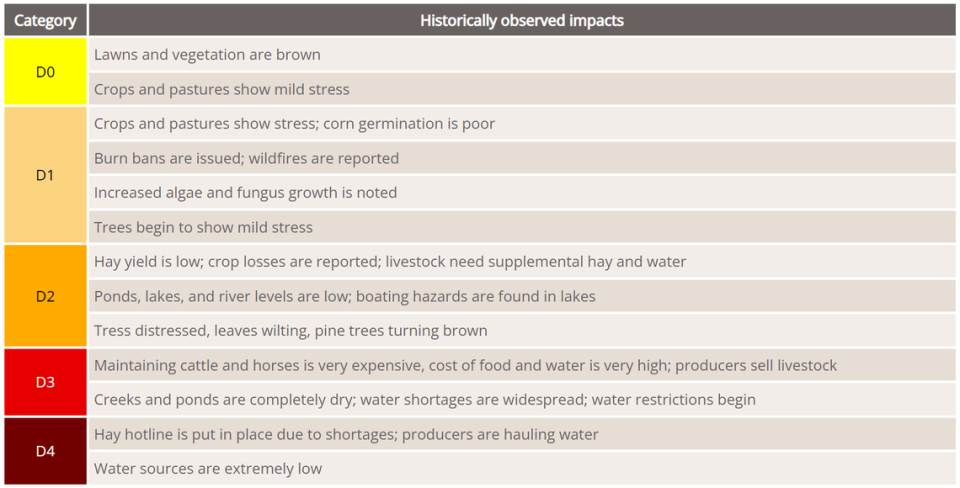One-third of KY is experiencing a drought. A meteorologist explains what it means
Almost 80% of the state is currently experiencing abnormally dry conditions with roughly 30% of Kentucky now under moderate drought, according to the U.S. Drought Monitor, headquartered at the University of Nebraska-Lincoln.
Though heavier rains fell this week across parts of the Midwest – the region Kentucky falls into – rapid drying is happening in the short-term, which leads to abnormally arid conditions and temporary moderate drought, according to a U.S. Drought Monitor’s regional summary.
“This week, short-term moderate drought was introduced or expanded across much of central Kentucky, the Illinois-Indiana border, and southeast Missouri,” the June 28 summary states. “Parts of Kentucky are seeing corn leaves curl as a result of the recent hot and dry weather.”
To help put these conditions into perspective, we asked Chris Bailey, the chief meteorologist at our reporting partner WKYT, to explain. We’ll get at what’s driving conditions here on the ground in Kentucky and what that means for people across the state.
What does it mean to experience a moderate drought in Kentucky?
“Moderate drought,” is the mildest level of drought, as defined by the U.S. Drought Monitor. It describes the hallmarks as poor germination, early signs of stress on crops, pastures and trees in general, increased algae and fungus growth, reports of wildfires and bans on burning.
In the table below, sourced from the U.S. Drought Monitor, moderate drought is labeled as D1.

For comparison, “abnormally dry” conditions are when you start to see lawns and vegetation turn brown, with crops and pastures showing initial signs of drought.
According to the U.S. Drought Monitor, a band of central Kentucky counties is currently experiencing moderate drought conditions. That area covers a little more than 30% of the entire state, a sharp uptick from the previous reporting week when moderate drought conditions only covered about 5% of Kentucky.
Fayette County, by contrast, currently falls into the abnormally dry category, which spans nearly 80% of Kentucky.
All told, more than a million Kentuckians are feeling the impact of these dry conditions, according to the U.S. Drought Monitor.
The last “true drought” gripped Kentucky beginning in late May of 2007 and ended nearly a year later on April 1, 2008 (46 weeks in total). During this time, the most intense period of drought occurred the week of Oct. 16, 2007, when exceptional drought (D4) stretched its hand over 16% of Kentucky’s land.
What’s fueling flash droughts across the country right now?
Though the North American Monsoon helped improve drought conditions in the Southwest this last week, flash drought fell upon parts of the Midwest, South and Southeast, where abnormally dry conditions are widespread with pockets of drought. Alaska has also seen warm and dry conditions, with massive wildfires.
“As of June 28, 2022, 42.53% of the U.S. and 47.73% of the lower 48 states are in drought,” the U.S. Drought Monitor reported.
Are these conditions cause for alarm in Kentucky?
According to Bailey, not quite yet. Or at least, not until the conditions become more persistent.
“It’s more of a short-term drought issue” at this point, Bailey told the Herald-Leader. He added: “This isn’t anything that is raising an alarm in my head right now.”
Looking at the longer-term drought index for Kentucky, that “does not have us even in any kind of abnormally dry,” conditions, Bailey said, calling what the state is experiencing now a flash drought.
Kentucky hasn’t gotten as many June thunderstorms as it normally does, which could explain why some people’s lawns are browning.
In the long term, however, the state is actually becoming wetter, Bailey said, attributing the shift to climate change and the steady flow of moist air from the Gulf of Mexico to the south.
“We are turning wetter, we’re turning stormier,” Bailey said, adding “I think you’re already seeing Kentucky becoming a wetter state.”
CORRECTION: This story has been corrected to better distinguish between a flash drought and a moderate drought. A flash drought is a drought that develops quickly, while a moderate drought is the mildest form of drought, as defined by the U.S. Drought Monitor service.
Do you have a question about the environment for our service journalism team? We’d like to hear from you. Fill out our Know Your Kentucky form or email ask@herald-leader.com.

